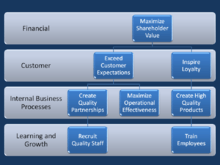Strategy map

| Strategy |
|---|
 |
|
Major dimensions |
|
Major thinkers |
|
Frameworks and tools |
A strategy map is a diagram that is used to document the primary strategic goals being pursued by an organization or management team. It is an element of the documentation associated with the Balanced Scorecard, and in particular is characteristic of the second generation of Balanced Scorecard designs that first appeared during the mid-1990s. The first diagrams of this type appeared in the early 1990s, and the idea of using this type of diagram to help document Balanced Scorecard was discussed in a paper by Drs. Robert S. Kaplan and David P. Norton in 1996.[1]
The strategy map idea featured in several books and articles during the late 1990s by Robert S. Kaplan and David P. Norton. Their original book in 1996 "The Balanced Scorecard, Translating strategy into action", contained diagrams which are later called strategy maps, but at this time they did nor refer to them as such.[2] Kaplan & Norton's Second book, The Strategy Focused organization, explicitly refers to strategy maps and includes a chapter on how to build them.[3] At this time they referred to "the relationship between the drivers and the desired outcomes constitute the hypotheses that define the strategy". Their Third book, Strategy Maps, goes into further detail about how to describe and visualise the strategy using strategy maps.[4]
The Kaplan and Norton approach to strategy maps has:
- An underlying framework of horizontal perspectives arranged in a cause and effect relationship. Typically Financial, Customer, Process and Learning & Growth
- Objectives within those perspectives. Each objective as text appearing within a shape (usually an oval or rectangle). Relatively few objectives (usually less than 20)
- Vertical sets of linked objectives that span the perspectives. These are called strategic themes.
- Clear cause and effect relationships between these objectives, across the perspectives. The strategic themes representing hypotheses about how the strategy will bring about change to the outcomes of the organisation.
Across a broader range of published sources [citation needed], a looser approach is sometimes used. In these approaches, there are only a few common attributes. Some approaches use a more broad causal relationships between objectives shown with arrows that either join objectives together, or placed in a way not linked with specific objectives but to provide general euphemistic indications of where causality lies. For instance, others, including Olve and Wetter in their 1999 book Performance Drivers also describe early performance driver models, but do not refer to them as strategy maps.[5]
The purpose of the strategy map in Balanced Scorecard design, and its emergence as a design aid, is discussed in some detail in a research paper on the evolution of Balanced Scorecard designs during the 1990s by Lawrie & Cobbold.[6]
Origin of strategy maps
The Balanced Scorecard is a framework that is used to help in the design and implementation of strategic performance management tools within organizations. The Balanced Scorecard provides a simple structure for representing the strategy to be implemented, and has become associated with a wide selection of design tools that facilitate the identification of measures and targets that can inform on the progress the organization is making in implementing the strategy selected ("activities"), and also provide feedback on whether the strategy is having the kind of impact on organizational performance that was hoped for ("outcomes"). By providing managers with this direct feedback on whether the required actions are being carried out, and whether they are working, the Balanced Scorecard is thought to help managers focus their attention more closely on the interventions necessary to ensure the strategy is effectively and efficiently executed.
One of the big challenges faced in the design of Balanced Scorecard based performance management systems is deciding what activities and outcomes to monitor. By providing a simple visual representation of the strategic objectives to be focused on, along with additional visual cues in the form of the perspectives and causal arrows, the strategy map has been found useful in enabling discussion within a management team about what objectives to choose, and subsequently to support discussion of the actual performance achieved.
Perspectives
Very early Balanced Scorecard articles by Robert S. Kaplan and David P.Norton[7] proposed a simple design method for choosing the content of the Balanced Scorecard based on answers to four generic questions about the strategy to be pursued by the organization. These four questions, one about finances, one about marketing, one about processes, and one about organizational development evolved quickly into a standard set of "perspectives" ("Financial", "Customer", "Internal Business Processes", "Learning & Growth").
Design of a Balanced Scorecard became a process of selecting a small number of objectives in each perspective, and then choosing measures and targets to inform on progress against this objective. But very quickly it was realized that the perspective headings chosen only worked for specific organisations (small to medium sized firms in North America - the target market of the Harvard Business Review), and during the mid to late 1990s papers began to be published arguing that other sets of headings would make more sense for specific organization types,[8] and that some organisations would benefit from using more or less than four headings.[9]
Despite these concerns, the 'standard' set of perspectives remains the most common, and traditionally is arrayed on the strategy map in the sequence (from bottom to top) "Learning & Growth", "Internal Business Processes", "Customer", "Financial" with causal arrows tending to flow "up" the page.[10]
Links between the strategy map and strategy development
The strategy map is a device that promotes three stages of conversation during the strategy development, implementation and learning process
- First to capture a strategy from a management team. To promote discussion amongst that team on the strategy, so they all leave the room telling the same story of their strategy.
- Secondly to communicate the strategy, focus organization efforts, and choose appropriate measures to report on an organisation's progress in implementing a strategy.
- Finally to provide a basis to review and potentially revise the strategy, (not simply the measures or targets) and support conversations and decision making, as the team learn from the strategy's implementation.
Over the years many have suggested [citation needed] that it can be used as, in part, a strategy development tool. Kaplan & Norton in their book "The Strategy Focused Organisation" [citation needed] argue that organisations could adopt 'industry standard' templates (basically a set of pre-determined strategic objectives).
See also
References
- ↑ Kaplan, Robert S.; Norton, David P. (Fall) [1996], "Linking the Balanced Scorecard to Strategy.", California Management Review, 39 (1) Check date values in:
|date=, |year= / |date= mismatch(help) - ↑ Kaplan, Robert S; Norton, David P. (1996). The Balanced Scorecard, Translating Strategy into Action. USA: Harvard Business Press. pp. 30–32 and 148–150. ISBN 0-87584-651-3.
- ↑ Kaplan, Robert s.; Norton, David P. (2001). The Strategy Focused Organization. USA: Harvard Business School Publishing. pp. Chapters 3, 4, 5 pp69–160. ISBN 1-57851-250-6.
- ↑ Kaplan, Robert p.; Norton, David P. (2004). Strategy Maps, Converting intangible assets into tangible outcomes. USA: Harvard Business School Publishing. ISBN 1-59139-134-2.
- ↑ Olve, Nils-Goran; Roy, Jan; Wetter, Magnus (1999), Performance Drivers: A practical guide to using the Balanced Scorecard, John Wiley & Sons
- ↑ Lawrie, Gavin J. G.; Cobbold, Ian (2004), "Third-generation Balanced Scorecard: evolution of an effective strategic control tool", International Journal of Productivity and Performance Management, 53 (7): 611–623, doi:10.1108/17410400410561231
- ↑ Kaplan, Robert S.; Norton, David P. (Jan–Feb 1992) [1992], "The Balanced Scorecard – Measures that Drive Performance", Harvard Business Review, 70 (1)
- ↑ Butler, A.; Letza, S. R.; Neale, B. (1997), "Linking the Balanced Scorecard to Strategy", International Journal of Strategic Management, 30 (2)
- ↑ Kennerley, M.; Neely, A. D. (2000), "Performance Measurement Frameworks – A Review", Proceedings, 2nd International Conference on Performance Measurement, Cambridge, UK
- ↑ Kaplan, Robert S.; David P. Norton (2004). Strategy Maps: Converting Intangible Assets into Tangible Outcomes. Boston, Massachusetts, USA: Harvard Business School Press. p. 7. ISBN 1-59139-134-2.
External links
| Wikimedia Commons has media related to Strategy maps. |